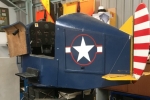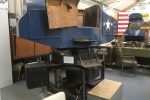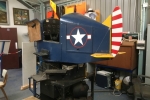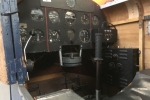Update from the Flight Simulators (part II) ……….

As mentioned in part I of the updates, with the lack of vacuum on the Link D4, the ANT-18 has been taking the brunt of the workload on the Link area. This trainer appears to date from 1940 and is operating with problems and limitations, some of which may be original.
As with other Link Trainers, it had been much modified before we acquired it. The Wind Drift Unit is unlikely to be original, and the instrument panel is reversed to clear space for the “radio” unit. It often struggles to regain level flight from a full bank but is more agile than the heavier D4, having the same actuators.
Some details on the ANT-18 type are below.
On other news, we had hoped to get some instruments operating in the Sycamore, but the work became very complex and time-consuming. The current idea is to fit Microsoft or other Flight Simulator. Driven by the existing controls, it will not detract from its exhibit value when not in use.
Another pair of hands with PC or Flight Simulator knowledge would be very useful.
Author:: The Link Team
Previous Simulator Part I Update
ANT-18
The most widely produced version of the Link Trainer was the ANT-18 (Army Navy Trainer model 18). This model was also produced in Canada for both the Royal Canadian Air Force and the Royal Air Force with a somewhat modified instrument panel. It was used by many countries for pilot training before and during the Second World War, used with the Harvard/SNJ.
The ANT-18 featured rotation through all three axes, effectively simulated all flight instruments, and modelled common conditions such as pre-stall buffet, over speed of the retractable undercarriage, and spinning. It was fitted with a removable opaque canopy, which could be used to simulate blind flying, and was particularly useful for instrument and navigation training. Our model was manufactured in 1940.
The trainer itself consists of a wooden box approximating the shape of a fuselage and cockpit, which is connected via a universal joint to a base. Inside the cockpit is a single pilot’s seat, primary and secondary aircraft controls, and a full suite of flight instruments.
The base contains the air-driven suction bellows to create movement, a vacuum pump which both drives the bellows and provides input to some aircraft instruments, a device known as a Telegon Oscillator which supplies power the remaining pilot and instructor instruments, and a Wind Drift analogue computer.
The second component is an external instructor’s desk, which consists of a large map table; a repeated display of the pilot’s main flight instruments; and the automatic recorder, a motorised ink marker also known as the “crab.” The crab is driven by the Wind Drift computer and moves across the glass surface of the map table, plotting the pilot’s track. The desk includes circuits for the pilot and instructor to communicate with each other via headphones and microphones, and controls for the instructor to alter wind direction and speed.
The Turning Motor can rotate the entire fuselage through 360-degree circles at variable rates of speed. A set of electrical slip ring contacts in the lower base compartment supplies electrical continuity between the fixed base and the movable fuselage.
Both the trainer and the instructor’s station are powered from standard 110VAC/240VAC power outlets via a transformer, with the bulk of internal wiring being low voltage. Simulator logic is all analogue and is based on vacuum.




Well done to all the Link Trainer ‘boys’.